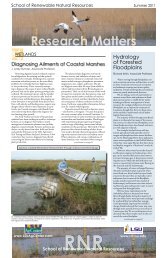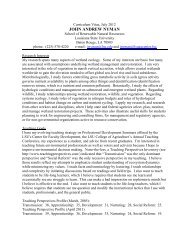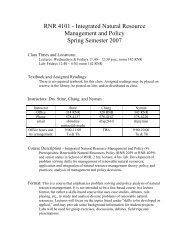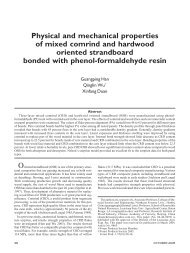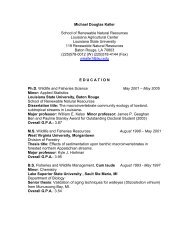Composite Materials Journal of Thermoplastic - LSU School of ...
Composite Materials Journal of Thermoplastic - LSU School of ...
Composite Materials Journal of Thermoplastic - LSU School of ...
You also want an ePaper? Increase the reach of your titles
YUMPU automatically turns print PDFs into web optimized ePapers that Google loves.
212 S.-Y. LEE ET AL.<br />
Table 1. Material formulations <strong>of</strong> the hybrids.<br />
PLA (wt%) WF (wt%) Talc (wt%) Silane (wt%)<br />
100 0 – –<br />
90 10 – –<br />
80 20 – –<br />
70 30 – –<br />
60 40 – –<br />
80 10 10 –<br />
70 20 10 –<br />
60 30 10 –<br />
50 40 10 –<br />
79 and 77 10 10 1 and 3<br />
69 and 67 20 10 1 and 3<br />
59 and 57 30 10 1 and 3<br />
49 and 47 40 10 1 and 3<br />
for 24 h in a vacuum oven to remove the absorbed moisture and cooled to<br />
room temperature, and then injection-molded at 1908C to form test samples.<br />
Thermal Analysis<br />
The thermal decomposition behavior <strong>of</strong> the composites was measured<br />
with a SDT Q600 Thermogravimetric analyzer (TA Instrument Inc., USA).<br />
Tests were done under nitrogen at a heating rate <strong>of</strong> 108C/min over a<br />
temperature range <strong>of</strong> 30–6008C. A sample <strong>of</strong> 5–10 mg was used for each run.<br />
The weight change was recorded as a function <strong>of</strong> heating temperature.<br />
Differential peak temperature (DT p ) was defined as the temperature <strong>of</strong> the<br />
maximum derivative <strong>of</strong> the weight change over time. DSC experiments were<br />
performed in a Q10 differential scanning calorimeter (TA Instrument Inc.,<br />
USA). Each sample was heated and cooled at a heating rate <strong>of</strong> 108C/min<br />
under nitrogen atmosphere. Each test sample <strong>of</strong> 5–10 mg was placed in an<br />
aluminum pan and heated from 30 to 2008C and then cooled down to 308C<br />
after keeping at 2008C for 3 min. The glass transition temperature (T g ),<br />
melting temperature (T m ), melting enthalpy (H m ), and crystallinity (X c )<br />
were determined from the first heating scan, while the crystallization<br />
temperature (T c ) and crystallization enthalpy (H c ) were obtained from the<br />
first cooling scan. T m is defined as the maximum <strong>of</strong> the endothermic melting<br />
peak and T g as the deflection <strong>of</strong> the baseline temperature from the first<br />
heating scan. The X c was obtained by the following expression:<br />
X c ð%Þ ¼<br />
H m<br />
H mðcrysÞ<br />
100<br />
ð1Þ<br />
Downloaded from http://jtc.sagepub.com at KAIST GRADUATE SCHOOL OF MGMT on April 27, 2008<br />
© 2008 SAGE Publications. All rights reserved. Not for commercial use or unauthorized distribution.





